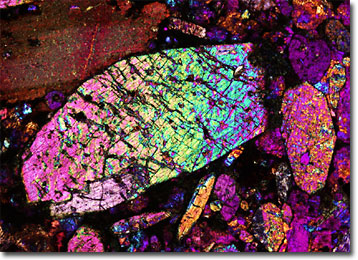Polarized Light Microscopy Digital Image Gallery
Malignite
Gabbros are a group of coarsely grained intrusive igneous rocks that are primarily composed of plagioclase feldspar and clinopyroxene. Chemically equivalent to basalt, gabbros are widely distributed on Earth as well as the moon.

Relatively dense, gabbros are formed when magma becomes trapped in cracks and between layers of other rocks underground and then slowly cools and crystallizes. This process often results in large bodies of gabbro, such as those found in the Adirondack Mountains, Scotland’s Isle of Skye, and South Africa. Typically dark in color and often banded, gabbros are sometimes utilized in the building industry, but are generally considered much more valuable as a source of copper, nickel, cobalt, platinum, and iron ores.
Malignite is a type of gabbro that derives its name from the Maligne River in Ontario, Canada where the type occurrence can be found. The rock generally contains nepheline and orthoclase feldspar in approximately equal amounts, each comprising approximately 20 percent of the rock. About half of the rock is composed of clinopyroxene, and the remaining ten percent of the gabbro’s composition usually consists of small amounts of sphene, biotite, and apatite. When the amount of nepheline is significantly lessened, the gabbro is no longer considered malignite, but instead is known as shonkinite.
